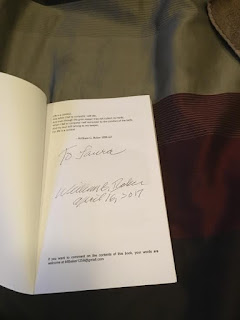You know that
infamous prison, Alcatraz, right? Where the worst of the worst men were
sentenced to jail on an island right across from the San Francisco Bay. Ever wondered what really happened inside that prison? What if I told you that an
actual prisoner wrote about his life living inside of Alcatraz’s jail cells for
four years?
William
G. Baker (Bill) wrote a book called Alcatraz #1259 which is about his life as a prisoner entering Alcatraz at
the age of twenty-three. Before going to Alcatraz, Bill was sentenced to the
Oregon State Penitentiary for auto theft for four years. While Bill was at the
Oregon State Penitentiary he tried to escape several times until he was sent to
Alcatraz and was given the number 1259-AZ (hence
the title of the book).
In the book Bill writes about his life growing up during the Great Depression.
His grandparents raised him because his mother didn’t have enough money to take
care of him and his little brother and his father ran off. Bill’s grandmother passed away so his
grandfather sent a letter to his mother demanding that she comes back and gets
him. Next, Bill’s mother remarried and life with his new stepfather was
anything but paradise. Now living on his stepfather’s farm in Kentucky, Bill
didn’t like his new life with his mother and stepfather so he started cutting
school and being a disobedient kid. Between the ages of ten or eleven, Bill ran
away from home and ended up getting caught by the police. After that his mother
and stepdad sent him to a reform school in Kentucky where he learned how fight
and smoke cigarettes. At the age
of sixteen, Bill’s stepfather didn’t want anything to do with him so he kicked
Bill out of the house.
Also
in his book, Bill writes about all of his experiences as a prisoner in all of
the prisons he spent time in, but the prison he talks about the most is
Alcatraz. From 1957-1960 Bill had to eat, work, and sleep behind the bars of
the most infamous prison. Bill describes about his time running into trouble
with the prison guards, learning how to play the card game, Bridge, from an
inmate. He also witnessed several inmates who attempted to escape the Alcatraz
but failed, and he learned how to forge checks. Finally, Bill does describe his
life after he was freed from Alcatraz in 1960. Sadly, he ended up living in and
out of other prisons again for counter fitting. At the end he met his wife and
is living happily out of prison.
In
concluding, if you have had a fascination for Alcatraz and want to know how
life was like living on an island behind bars I would recommend reading Alcatraz #1259. William G. Baker does a great job writing his own memoir about life living
in prison and making people think what the life is actually like living behind
bars.
Side note: the
picture on the cover of his book is Bill’s mug shot at Alcatraz and yes I did
meet him on Easter Sunday when my husband and I went to visit Alcatraz (my
first visit and my husband’s second visit).
Trivia
Questions:
1) One of Bill’s
inmates, Benny Rayburn, got his sentenced reduced at Alcatraz, how?
2) Why did Bill
go back to Alcatraz in 2013 to spend the night in his cell?










